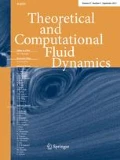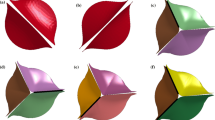Abstract
Bicuspid aortic valve (BAV) is a congenital heart defect that has been associated with serious aortopathies, such as aortic stenosis, aortic regurgitation, infective endocarditis, aortic dissection, calcific aortic valve and dilatation of ascending aorta. There are two main hypotheses to explain the increase prevalence of aortopathies in patients with BAV: the genetic and the hemodynamic. In this study, we seek to investigate the possible role of hemodynamic factors as causes of BAV-associated aortopathy. We employ the curvilinear immersed boundary method coupled with an efficient thin-shell finite-element formulation for tissues to carry out fluid–structure interaction simulations of a healthy trileaflet aortic valve (TAV) and a BAV placed in the same anatomic aorta. The computed results reveal major differences between the TAV and BAV flow patterns. These include: the dynamics of the aortic valve vortex ring formation and break up; the large-scale flow patterns in the ascending aorta; the shear stress magnitude, directions, and dynamics on the heart valve surfaces. The computed results are in qualitative agreement with in vivo magnetic resonance imaging data and suggest that the linkages between BAV aortopathy and hemodynamics deserve further investigation.
Similar content being viewed by others
References
Roberts W.C.: The congenitally bicuspid aortic valve: a study of autopsy cases. Am. J. Cardiol. 85(85), 72–83 (1970)
Fedak P.W., Verma S., David T.E., Leask R.L., Weisel R.D., Butany J.: Clinical and pathophysiological implications of a bicuspid aortic valve. Circulation 106, 900–904 (2002)
Sievers H.H., Schmidtke C.: A classification system for the bicuspid aortic valve from 304 surgical specimens. J. Thorac. Cardiovasc. Surg. 133, 1226–1233 (2007)
Ward C.: Clinical significance of the bicuspid aortic valve. Heart 83, 81–85 (2000)
Girdauskas E., Borger M.A., Secknus M.A., Girdauskas G., Kuntze T.: Is aortopathy in bicuspid aortic valve disease a congenital defect or a result of abnormal hemodynamics? a critical reappraisal of a one-sided argument. Eur. J. Cardiothorac. Surg. 39, 809–814 (2011)
Kari F.A., Fazel S.S., Mitchell R.S., Fischbein M.P., Miller D.C.: Bicuspid aortic valve configuration and aortopathy pattern might represent different pathophysiologic substrates. J. Thorac. Cardiovasc. Surg. 144, 516–517 (2012)
Robicsek F., Thubrikar M.J., Cook J.W., Fowler B.: The congenitally bicuspid aortic valve: How does it function? Why does it fail?. Ann. Thorac. Surg. 77, 177–185 (2004)
Bonow R.O.: Bicuspid aortic valves and dilated aortas: a critical review of the critical review of the ACC/AHA practice guidelines recommendations. Am. J. Cardiol. 102, 111–114 (2008)
Barker A.J., Markl M., Bürk J., Lorenz R., Bock J., Bauer S., Schulz-Menger J., von Knobelsdorff-Brenkenhoff F.: Bicuspid aortic valve is associated with altered wall shear stress in the ascending aorta. Circ. Cardiovasc. Imaging 5, 457–466 (2012)
Corte A.D., Quarto C., Bancone C., Castaldo C., Di Meglio F., Nurzynska D., De Santo L.S., Feo M., Scardone M., Montagnani S., Cotrufo M.: Spatiotemporal patterns of smooth muscle cell changes in ascending aortic dilatation with bicuspid and tricuspid aortic valve stenosis: focus on cell-matrix signaling. J. Thorac. Cardiovasc. Surg. 135, 8–18 (2008)
Tadros T.M., Klein M.D., Shapira O.M.: Ascending aortic dilatation associated with bicuspid aortic valve: pathophysiology, molecular biology, and clinical implications. Circulation 119, 880–890 (2009)
Bauer M., Siniawski H., Pasic M., Schaumann B., Hetzer R.: Different hemodynamic stress of the ascending aorta wall in patients with bicuspid and tricuspid aortic valve. J. Card. Surg. 21, 218–220 (2006)
Hope M.D., Hope T.A., Meadows A.K., Ordovas K.G., Urbania T.H., Alley M.T., Higgins C.B.: Bicuspid aortic valve: four-dimensional mr evaluation of ascending aortic systolic flow patterns. Radiology 255, 53–61 (2010)
Sievers H.H., Sievers H.L.: Aortopathy in bicuspid aortic valve disease genes or hemodynamics? or Scylla and Charybdis?. Editor. Eur. J. Cardiothorac. Surg. 39, 803–804 (2011)
Padang R., Bannon P.G., Jeremy R., Richmond D.R., Semsarian C., Vallely M., Wilson M., Yan T.D.: The genetic and molecular basis of bicuspid aortic valve associated thoracic aortopathy: a link to phenotype heterogeneity. Ann. Cardiothorac. Surg. 2, 83–91 (2013)
Mordi I., Tzemos N.: Bicuspid aortic valve disease: a comprehensive review. Cardiol. Res. Pract. 2012, 1–7 (2012)
Bissell M.M., Hess A.T., Biasiolli L., Glaze S.J., Loudon M., Pitcher A., Davis A., Prendergast B., Markl M., Barker A.J., Neubauer S., Myerson S.G.: Aortic dilation in bicuspid aortic valve disease flow pattern is a major contributor and differs with valve fusion type. Circ. Cardiovasc. Imaging 6, 499–507 (2013)
Nathan D.P., Xu C., Plappert T. et al.: Increased ascending aortic wall stress in patients with bicuspid aortic valves. Ann. Thorac. Surg. 92, 1384–1389 (2011)
De Hart J., Peters G.W.M., Schreurs P.J.G., Baaijens FPT.: A three-dimensional computational analysis of fluid–structure interaction in the aortic valve. J. Biomech. 36(1), 103–112 (2003)
Einstein D.R., Kunzelman K.S., Reinhall P.G., Nicosia M.A., Cochran R.P.: Non-linear fluid-coupled computational model of the mitral valve. J. Heart Valve Dis. 14, 376–385 (2005)
Weinberg E.J., Mofrad M.R.K.: A multiscale computational comparison of the bicuspid and tricuspid aortic valves in relation to calcific aortic stenosis. J. Biomech. 41, 3482–3487 (2008)
Sotiropoulos F., Yang X.: Immersed boundary methods for simulating fluid–structure interaction. Prog. Aerosp. Sci. 65, 1–21 (2014)
Borazjani I.: Fluid–structure interaction, immersed boundary – finite element method simulations of bio-prosthetic heart valves. Comput. Methods Appl. Mech. Eng. 257, 103–116 (2013)
Le T.B., Sotiropoulos F.: Fluid–structure interaction of an aortic heart valve prosthesis driven by an animated anatomic left ventricle. J. Comput. Phys. 244, 41–62 (2013)
Chandra S., Rajamannan N.M., Sucosky P.: Computational assessment of bicuspid aortic valve wall-shear stress: implications for calcific aortic valve disease. Biomech. Model. Mechanobiol. 11, 1085–1096 (2012)
Jermihov P.N., Jia L., Sacks M.S., Gorman R.C., Gorman J.H. III, Chandran K.B.: Effect of geometry on the leaflet stresses in simulated models of congenital bicuspid aortic valves. Cardiovasc. Eng. Technol. 2, 48–56 (2011)
Ge L., Sotiropoulos F.: A numerical method for solving the 3D unsteady incompressible Navier–Stokes equations in curvilinear domains with complex immersed boundaries. J. Comput. Phys. 225(2), 1782–1809 (2007)
Stolarski H., Gilmanov A., Sotiropoulos F.: Non-linear rotation-free 3-node shell finite-element formulation. Int. J. Numer. Methods Eng. 2013(95), 740–770 (2013)
Braverman A.C., Güven H., Beardslee M.A., Makan M., Kates A.M., Moon M.R.: The bicuspid aortic valve. Curr. Probl. Cardiol. 30, 470–522 (2005)
Gilmanov A., Sotiropoulos F.: A hybrid cartesian/immersed boundary method for simulating flows with 3D, geometrically complex, moving bodies. J. Comput. Phys. 207(2), 457 (2005)
Borazjani I., Ge L., Sotiropoulos F.: Curvilinear immersed boundary method for simulating fluid–structure interaction with complex 3D rigid bodies. J. Comput. Phys. 227(16), 7587–7620 (2008)
Felippa C.A., Park K.C., Farhat C.: Partitioned analysis of coupled mechanical systems. Comput. Methods Appl. Mech. Eng. 190(24–25), 3247–3270 (2001)
Fernandez M.A., Gerbeau J.-F., Grandmont C.: A projection semi-implicit scheme for the coupling of an elastic structure with an incompressible fluid. Int. J. Numer. Methods Eng. 69, 794–821 (2007)
Küttler U., Wall W.: Fixed-point fluid–structure interaction solvers with dynamic relaxation. Comput. Mech. 43, 61–72 (2008)
Gilmanov, A., Le, T.B., Sotiropoulos, F: A numerical approach for simulating fluid structure interaction of flexible thin 481 shells undergoing arbitrarily large deformations in complex domains. J. Comput. Phys. 300, 814–843 (2015)
Carmody C.J., Burriesci G., Howard I.C., Patterson E.A.: An approach to the simulation of fluid–structure interaction in the aortic valve. J. Biomech. 39, 158–169 (2006)
Liu J.S., Lu P.C., Chu S.H.: Turbulence characteristics downstream of bileaflet aortic valve prostheses. J. Biomech. Eng. 122, 118–124 (2000)
Loudon C., Tordesillas A.: The use of the dimensionless Womersley number to characterize the unsteady nature of internal flow. J. Theor. Biol. 191, 63–78 (1998)
Beppu S., Suzuki S., Matsuda H., Ohmori F., Nagata S., Miyatake K.: Rapidity of progression of aortic stenosis in patients with congenital bicuspid aortic valves. Am. J. Cardiol. 71, 322–327 (1993)
Garcia D., Kadem L.: What do you mean by aortic valve area: Geometric orifice area, effective orifice area, or gorlin area?. J. Heart Valve Dis. 15, 601–608 (2005)
Baumgartner H., Hung J., Bermejo J., Chambers J.B., Evangelista A., Griffin B.P., Iung B., Otto C.M., Pellikka P.A., Quinõnes M.: Echocardiographic assessment of valve stenosis: EAE/ASE recommendations for clinical practice. Eur. J. Echocardiogr. 10, 1–25 (2009)
Otto C.M., Lind B.K., Kitzman D.W., Gersh B.J., Siscovick D.S.: Association of aortic valve sclerosis with cardiovascular mortality and morbidity in the elderly. N. Engl. J. Med. 341, 142–147 (1999)
Cecconi M., Marnfrin M., Moraca A., Zanoli R., Colonna P.L., Bettuzzi M.G., Moretti S., Gabrielli D., Perna G.P.: Aortic dimensions in patients with bicuspid aortic valve without significant valve dysfunction. Am. J. Cardiol. 95, 292–294 (2005)
Butcher J.T., Mahler G.J., Hockaday L.A.: Aortic valve disease and treatment: the need for naturally engineered solutions. Adv. Drug Deliv. Rev. 63, 242–268 (2011)
Malek A., Alper S., Izumo S.: Hemodynamic shear stress and its role in atherosclerosis. J. Am. Med. Assoc. 282, 2035–2042 (1999)
Ge, L., Sotiropoulos, F.: Direction and magnitude of blood flow shear stresses on the leaflets of aortic valves: Is there a link with valve calcification?. J. Biomech. Eng. 132, 014505.1–014505.5 (2010)
He X, Ku D.N.: Pulsatile flow in the human left coronary artery bifurcation: average conditions. J. Biomech. Eng. 118, 74–82 (1996)
Hunt, J.C.R., Wray, A.A., Moin, P.: Eddies, Streams, and Convergence Zones in Turbulent Flows. In: Proceedings of 1988 Summer Program, Stanford N.A.S.A. Centre for Turbulence Research, CTR-S88, vol. 736, pp. 193–208 (1988)
Bissell M.M., Dall’Armellina E., Choudhury R.P.: Flow vortices in the aortic root: in vivo 4D-MRI confirms predictions of leonardo da vinci. Eur. Heart J. 35, 1344 (2014)
Mahadevia R., Barker A.J., Schnell S., Entezari P., Kansal P., Fedak P.W.M., Malaisrie S.C., McCarthy P., Collins J., Carr J., Markl M.: Bicuspid aortic cusp fusion morphology alters aortic three-dimensional outflow patterns, wall shear stress, and expression of aortopathy. Circulation 129, 673–682 (2014)
Author information
Authors and Affiliations
Corresponding author
Additional information
Communicated by Jeff D. Eldredge.
Rights and permissions
About this article
Cite this article
Gilmanov, A., Sotiropoulos, F. Comparative hemodynamics in an aorta with bicuspid and trileaflet valves. Theor. Comput. Fluid Dyn. 30, 67–85 (2016). https://doi.org/10.1007/s00162-015-0364-7
Received:
Accepted:
Published:
Issue Date:
DOI: https://doi.org/10.1007/s00162-015-0364-7




